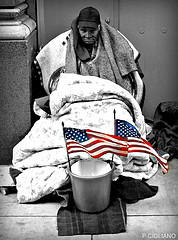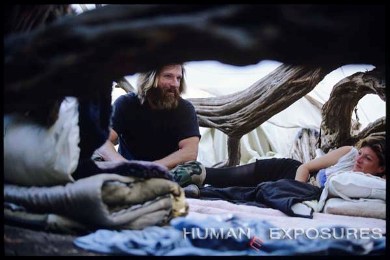 It is a fact of the modern, media-driven mentality that celebrities attract a lot of attention. This is frequently leveraged, where possible, to attract attention to causes of various sorts. Back in my home town of New Orleans, Brad Pitt is the resident champion of sustainable housing. Jerry Lewis has his famous telethon; Oprah consistently casts her spotlight on social issues, and so on.
It is a fact of the modern, media-driven mentality that celebrities attract a lot of attention. This is frequently leveraged, where possible, to attract attention to causes of various sorts. Back in my home town of New Orleans, Brad Pitt is the resident champion of sustainable housing. Jerry Lewis has his famous telethon; Oprah consistently casts her spotlight on social issues, and so on.
Today, another celebrity is in the news as he tries to attract the eyes and the ears to the plight of the homeless — Jesse Jackson. Rev. Jackson will be spending the night in a homeless shelter in the San Francisco’s Mission District.
Jackson observed the following in a statement to San Francisco’s ABC 7 :
‘Two things strike me when I come to the homeless shelter, the number of people who are working by day who live in the homeless shelter and the number of children in these shelters who in fact end up being disconnected from school,’ said Jackson.
This is what we all need to keep in mind. This is not a partisan issue, it is a human issue. There is not an ounce of liberal or conservative agenda in the simple and chilling observation I just quoted. It was only yesterday that I was writing about the importance of staying in school.
There are many homeless people in the U.S. — and the numbers grow daily — who, while employed, have suddenly found themselves bereft of a roof. It could be a subprime home loan, accumulation of debt, or a variety of other factors, but the simple reality is that more and more everyday people are hitting the streets.
Jackson is a colorful character, and I am sure that his overnight stay will attract a lot of attention. I certainly hope that it helps. Every effort to raise awareness is important.
Source: “Jesse Jackson spends night in homeless shelter,” ABC 7 San Francisco, 10/26/10
Image by PublicResource.org, used under its Creative Commons license.
Visit Us on Facebook: Humane Exposures Publishing, downTownUSA, Maggots in My Sweet Potatoes, It’s More Expensive To Do Nothing.

 A report card that examines the treatment of mothers and pregnant women in prison has been issued recently, and several states are none too happy about the grades they’ve received. (California scored a cumulative “C-” in case you are curious.)
A report card that examines the treatment of mothers and pregnant women in prison has been issued recently, and several states are none too happy about the grades they’ve received. (California scored a cumulative “C-” in case you are curious.) Judge Michael Tynan’s fourth-floor courtroom in downtown L.A.’s Criminal Courts building is in our spotlight today. It’s a room that’s usually packed with people that are often discarded by society: the addicts, the mentally ill or disadvantaged, the homeless, and, more recently, the female parolees.
Judge Michael Tynan’s fourth-floor courtroom in downtown L.A.’s Criminal Courts building is in our spotlight today. It’s a room that’s usually packed with people that are often discarded by society: the addicts, the mentally ill or disadvantaged, the homeless, and, more recently, the female parolees. San Diego’s yearly Stand Down event just passed recently, hosted by one of the oldest and most well-known programs to help homeless veterans. In case you’re not familiar with it,
San Diego’s yearly Stand Down event just passed recently, hosted by one of the oldest and most well-known programs to help homeless veterans. In case you’re not familiar with it, 
 Here at HUMAN
Here at HUMAN The campus of Vista Del Mar Child and Family Services last Wednesday was the epicenter of an enormous change for California. Governor Schwarzenegger performed a ceremonial signing of Assembly Bill 12, a bill that will keep foster care kids from aging out of the system when they turn 18. Schwarzenegger called the idea of taking care of oneself at 18 “ludicrous.”
The campus of Vista Del Mar Child and Family Services last Wednesday was the epicenter of an enormous change for California. Governor Schwarzenegger performed a ceremonial signing of Assembly Bill 12, a bill that will keep foster care kids from aging out of the system when they turn 18. Schwarzenegger called the idea of taking care of oneself at 18 “ludicrous.” It was not all that long ago that we wrote about a
It was not all that long ago that we wrote about a  Mark Allen Johnson started shooting images in 2003. Since then, he has done photography for a stunning array of clients including Newsweek, Time, The New York Times, Marie Claire, The Economist, and VIBE. In addition he, like all photographers, pursues his own projects. It is one of those we’d like to speak of today: Pregnant in Prison.
Mark Allen Johnson started shooting images in 2003. Since then, he has done photography for a stunning array of clients including Newsweek, Time, The New York Times, Marie Claire, The Economist, and VIBE. In addition he, like all photographers, pursues his own projects. It is one of those we’d like to speak of today: Pregnant in Prison.








